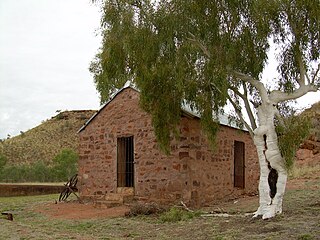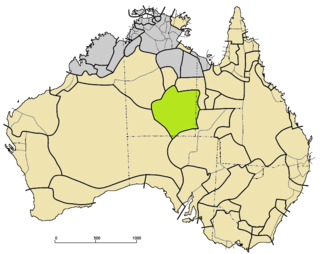Tjilpa is the name given to a marsupial cat amongst the Northern Aranda language group of Australian Aboriginal people. There are many Dreamtime stories of tribes of ancestral Tjilpa-men, who had a significant mythological role. The geographical range of these stories includes Aranda, Anmatyerre, Kaytetye, Ngalia, Ilpara and Kukatja lands.

The Australian Aboriginal languages consist of around 290–363 languages belonging to an estimated 28 language families and isolates, spoken by Aboriginal Australians of mainland Australia and a few nearby islands. The relationships between these languages are not clear at present. Despite this uncertainty, the Indigenous Australian languages are collectively covered by the technical term "Australian languages", or the "Australian family".

The Pama–Nyungan languages are the most widespread family of Australian Aboriginal languages, containing perhaps 300 languages. The name "Pama–Nyungan" is derived from the names of the two most widely separated groups, the Pama languages of the northeast and the Nyungan languages of the southwest. The words pama and nyunga mean "man" in their respective languages.

The Warlpiri are a group of Indigenous Australians, many of whom speak the Warlpiri language. There are 5,000–6,000 Warlpiri, living mostly in a few towns and settlements scattered through their traditional land in Australia's Northern Territory, north and west of Alice Springs. About 3,000 still speak the Warlpiri language. The word "Warlpiri" has also been romanised as Walpiri, Walbiri, Elpira, Ilpara and Wailbri.

Barrow Creek is a very small town, with a current population of 11, in the southern Northern Territory of Australia. It is located on the Stuart Highway, about 280 km north of Alice Springs, about halfway from there to Tennant Creek. The main feature of the town is the roadhouse/hotel. A number of mining companies are currently exploring in the area, although none of the current residents are involved in the mining industry.
Many Australian Aboriginal cultures have or traditionally had a manually coded language, a signed counterpart of their oral language. This appears to be connected with various speech taboos between certain kin or at particular times, such as during a mourning period for women or during initiation ceremonies for men, as was also the case with Caucasian Sign Language but not Plains Indian Sign Language, which did not involve speech taboo, or deaf sign languages, which are not encodings of oral language. There is some similarity between neighboring groups and some contact pidgin similar to Plains Indian Sign Language in the American Great Plains.

Arrernte or Aranda or sometimes referred to as Upper Arrernte, is a dialect cluster in the Arandic language group spoken in parts of the Northern Territory, Australia, by the Arrernte people. Other spelling variations are Arunta or Arrarnta, and all of the dialects have multiple other names.

Cyperus bulbosus is a species of sedge found across Africa, the Middle East, Indian subcontinent, Southeast Asia, and Australia. In Australia, it is commonly called (Australian) bush onion or "wild onion", but is not related to the onion or other Alliaceae. It is a component of Australian bushfood, but is considered an agricultural weed in other areas.

English is a West Germanic language that was first spoken in early medieval England and eventually became a global lingua franca. It is named after the Angles, one of the Germanic tribes that migrated to the area of Great Britain that later took their name, as England. Both names derive from Anglia, a peninsula in the Baltic Sea. The language is closely related to Frisian and Low Saxon, and its vocabulary has been significantly influenced by other Germanic languages, particularly Norse, and to a greater extent by Latin and French.
The Warumungu are a group of Indigenous Australians of the Northern Territory. Modern day Warumungu are mainly concentrated in the region of Tennant Creek and Alice Springs.

Arandic is a family of Australian Aboriginal languages consisting of several languages or dialect clusters, including the Arrernte group, Lower Arrernte, Pertame language and Kaytetye.
Wagaya (Wakaya) is an extinct Australian Aboriginal language of Queensland. Yindjilandji (Indjilandji) may have been a separate language.
Akitiri Sign Language, also known as Eltye eltyarrenke, is a highly developed Australian Aboriginal sign language used by the Kaytetye people of northern Australia.

The Living Archive of Aboriginal Languages is a digital archive of endangered literature in over forty Australian Indigenous languages from the Northern Territory, Australia. The project to build the archive was initially funded in 2012 by the Australian Research Council and involved the collaboration of the Charles Darwin University as the lead institution, the Northern Territory Government and the Australian National University. Later partners include the Batchelor Institute of Indigenous Tertiary Education, the Northern Territory Library and the Northern Territory Catholic Education Office.

The Wakaya are an indigenous Australian people of the Northern Territory.

Erlikilyika (c.1865–c.1930), known to Europeans by the name Jim Kite or Jim Kyte or Jim Kite Penangke, was an Aboriginal Australian sculptor, artist and anthropological interpreter. He was an Arrernte man, born into the Southern Arrernte or Pertame language group in Central Australia. He was the first Central Australian artist to be nationally recognised for his artistic talent, in particular his carvings of animals in soft stone, illustrations and sculptures, after an exhibition of his work was held in Adelaide, South Australia in 1913.

Ali Curung is an Indigenous Australian community in the Barkly Region of the Northern Territory. The community is located 170 km south of Tennant Creek, and 378 km north of Alice Springs. At the 2016 census, the community had a population of 494.












